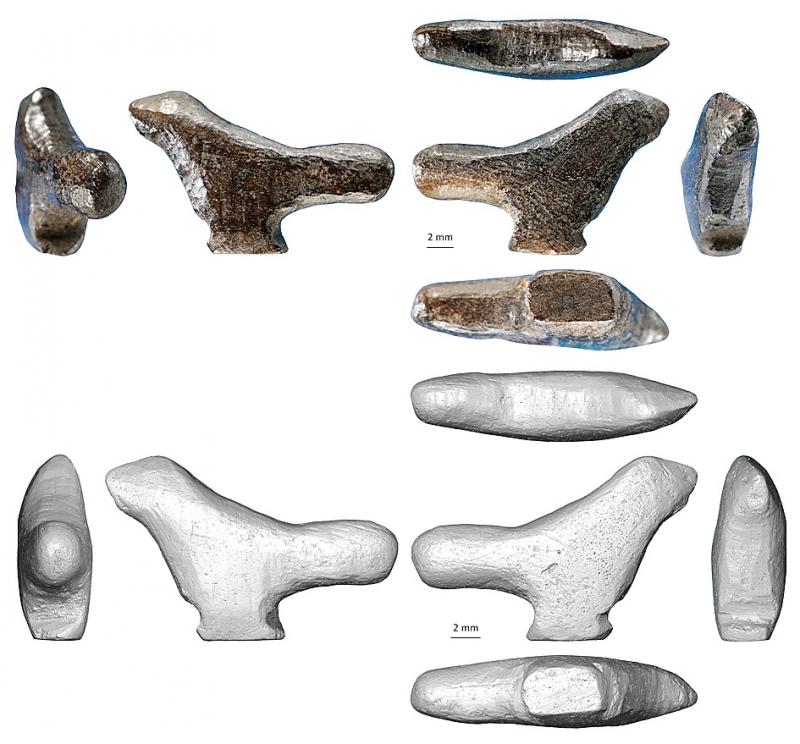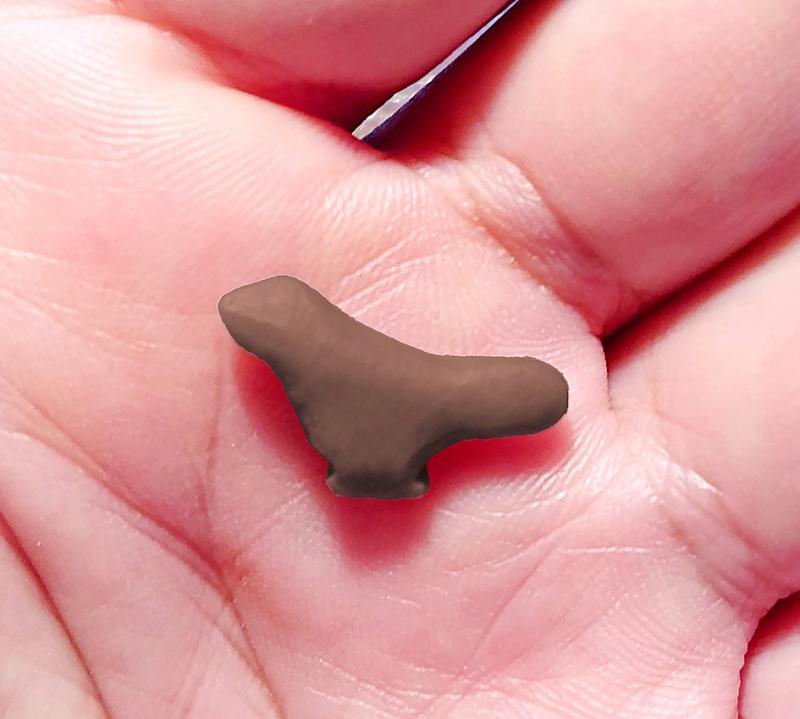A miniature bird sculpted out of burnt bone in China about 13,500 years ago is the oldest known figurine from East Asia, researchers who discovered it in a refuse heap near an archeological site said.
The carefully crafted depiction of a songbird on a pedestal — smaller than an almond kernel — was found among burnt animal remains and fragments of ceramics at Lingjing in north ce ntral Henan Province, an area thought to have been home to some of China’s earliest civilizations.
The figurine is the “oldest known carving from East Asia,” said Francesco D’Errico of the University of Bordeaux, who coauthored the research published in the journal PLOS One on Wednesday.

Photo: AFP / CNRS / University of Bergen / Francesco D‘E’rrico / L. Doyon
“It shows that in this region sculpture starts at least 13,500 years ago and fills in a gap in our knowledge about the origin of art in this vast region,” he said.
The tiny carving was discovered by lead author Li Zhanyang (李占陽) of Shandong University, who has been excavating parts of the Lingjing site since 2005. Digging in the area had already revealed 11 distinct layers, ranging in age from 120,000 years ago to the Bronze Age.
Most of the fifth layer had been removed during a well-digging operation in 1958 and disposed of at a refuse heap nearby.

Photo: AFP / CNRS / University of Bergen / Francesco D‘E’rrico / L. Doyon
That dumping area was still intact years later, and when the authors sifted through the soil they found several artifacts, including pottery shards, burned animal remains and the bird figurine.
The carving is just 19.2mm long, 5.1mm wide and 12.5mm high.
Researchers were unable to use radiocarbon dating on the bird itself because the process would have damaged it, but they dated similar bones found with it, including one gouged using the same technique.
In this way they estimated the age of the bird figurine to be 13,500 years, which they said predates previously known figurines from this region by almost 8,500 years.
D’Errico said the bird was “exceptionally” well preserved, enabling researchers to trace the various carving methods used to create different parts of the figure, including gouging with a stone tool, scraping and polishing.
“Our observations show that the artist knew well which technique was the more adapted to carve the different parts of the animal,” he said.
“What is also remarkable is that the carving is not a fully realistic representation of a bird,” he said.
The figurine has an oversized tail, allowing it to balance on its pedestal.
“Without this trick the bird would fall on its head,” D’Errico said, adding that this shows the carving is not just a “casual experiment.”
The authors said that the craftsmanship suggests the advanced stage of an artistic tradition, which began much earlier.
In recent years, cave paintings in the Indonesian islands of Borneo and Sulawesi have been dated as more than 40,000 years old, suggesting ancient societies with advanced artistic cultures in the region.
While 3D portable art has been documented in Europe dating back about 40,000 years, the researchers said the Lingjing bird was the oldest such example found in East Asia.
Palaeolithic hunter-gatherers in China are known to have manufactured bone tools, such as spear points and needles, as well as personal ornaments made of shells, ostrich eggs and animal teeth, D’Errico said.
“The carving of objects with no apparent functional purpose, requiring a dedicated apprenticeship to be made, opens a new window on these societies,” he added.

A feud has broken out between the top leaders of the far-right Alternative for Germany (AfD) party on whether to maintain close ties with Russia. The AfD leader Alice Weidel this week slammed planned visits to Russia by some party lawmakers, while coleader Tino Chrupalla voiced a defense of Russian President Vladimir Putin. The unusual split comes at a time when mainstream politicians have accused the anti-immigration AfD of acting as stooges for the Kremlin and even spying for Russia. The row has also erupted in a year in which the AfD is flying high, often polling above the record 20 percent it

Philippine President Ferdinand Marcos Jr yesterday vowed that those behind bogus flood control projects would be arrested before Christmas, days after deadly back-to-back typhoons left swathes of the country underwater. Scores of construction firm owners, government officials and lawmakers — including Marcos’ cousin congressman — have been accused of pocketing funds for substandard or so-called “ghost” infrastructure projects. The Philippine Department of Finance has estimated the nation’s economy lost up to 118.5 billion pesos (US$2 billion) since 2023 due to corruption in flood control projects. Criminal cases against most of the people implicated are nearly complete, Marcos told reporters. “We don’t file cases for

Ecuadorans are today to vote on whether to allow the return of foreign military bases and the drafting of a new constitution that could give the country’s president more power. Voters are to decide on the presence of foreign military bases, which have been banned on Ecuadoran soil since 2008. A “yes” vote would likely bring the return of the US military to the Manta air base on the Pacific coast — once a hub for US anti-drug operations. Other questions concern ending public funding for political parties, reducing the number of lawmakers and creating an elected body that would

‘ATTACK ON CIVILIZATION’: The culture ministry released drawings of six missing statues representing the Roman goddess of Venus, the tallest of which was 40cm Investigators believe that the theft of several ancient statues dating back to the Roman era from Syria’s national museum was likely the work of an individual, not an organized gang, officials said on Wednesday. The National Museum of Damascus was closed after the heist was discovered early on Monday. The museum had reopened in January as the country recovers from a 14-year civil war and the fall of the 54-year al-Assad dynasty last year. On Wednesday, a security vehicle was parked outside the main gate of the museum in central Damascus while security guards stood nearby. People were not allowed in because